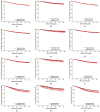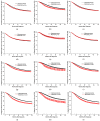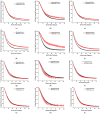Location Has Prognostic Impact on the Outcome of Colorectal Mucinous Adenocarcinomas
- PMID: 38201574
- PMCID: PMC10778219
- DOI: 10.3390/cancers16010147
Location Has Prognostic Impact on the Outcome of Colorectal Mucinous Adenocarcinomas
Abstract
Mucinous (colloid) adenocarcinomas (MAs) are a rare histological subtype of tumors defined by extracellular mucin comprising more than 50% of the tumor. These tumors are on a continuum of mucin-producing malignancies with signet ring cell adenocarcinomas (SRCCs), which instead produce intracellular mucin. Mucin-containing cancers occur primarily in the stomach and colon, where for SRCCs, outcomes are relatively worse in the proximal stomach and the rectum. It is not known if MAs have similar outcomes. In this study, we use the Surveillance, Epidemiology, and End Results (SEER) database to examine the effects of tumor localization, age, sex, and stage on colorectal and gastric cancer outcomes for MAs. For right colon cancers, MAs are more common, particularly in females, and have slightly better or equivalent outcomes across all stages and ages compared to conventional adenocarcinomas, but outcomes are progressively worse compared to conventional adenocarcinomas for left colon and rectal cancers. Unlike SRCCs, MAs have similar outcomes to conventional adenocarcinomas in all stomach locations. Overall, these results suggest that MAs have an intrinsically different tumor biology in the left colon and rectum that promotes pathogenesis. Decoding this phenomenon could lead to more effectively tailored patient treatment regimens.
Keywords: cancer; chemotherapy; colloid adenocarcinomas; epidemiology; histopathology; radiotherapy; signet ring cell adenocarcinomas; surgery; survival outcomes.
Conflict of interest statement
The authors declare no conflict of interest.
Figures





Similar articles
-
Effects of Tumor Localization, Age, and Stage on the Outcomes of Gastric and Colorectal Signet Ring Cell Adenocarcinomas.Cancers (Basel). 2023 Jan 24;15(3):714. doi: 10.3390/cancers15030714. Cancers (Basel). 2023. PMID: 36765680 Free PMC article.
-
Epidemiology of Mucinous Adenocarcinomas.Cancers (Basel). 2020 Oct 30;12(11):3193. doi: 10.3390/cancers12113193. Cancers (Basel). 2020. PMID: 33143115 Free PMC article.
-
Epidemiology of Signet Ring Cell Adenocarcinomas.Cancers (Basel). 2020 Jun 11;12(6):1544. doi: 10.3390/cancers12061544. Cancers (Basel). 2020. PMID: 32545410 Free PMC article.
-
[Influence of mucinous and signet-ring cell differentiation on epidemiological, histological, molecular biological features, and outcome in patients with colorectal carcinoma].Zentralbl Chir. 2013 Aug;138(4):427-33. doi: 10.1055/s-0031-1283870. Epub 2012 Jan 24. Zentralbl Chir. 2013. PMID: 22274919 Review. German.
-
Malignant Transformation of Long-Standing Ileal Crohn's Disease Likely Favors Signet Ring Cell Adenocarcinoma Histology.World J Oncol. 2023 Dec;14(6):447-456. doi: 10.14740/wjon1605. Epub 2023 Nov 18. World J Oncol. 2023. PMID: 38022405 Free PMC article. Review.
Cited by
-
Onset and prognostic features of anastomotic leakage in patients undergoing radical surgery after neoadjuvant chemoradiation for rectal cancer.World J Gastrointest Surg. 2024 Dec 27;16(12):3710-3719. doi: 10.4240/wjgs.v16.i12.3710. World J Gastrointest Surg. 2024. PMID: 39734438 Free PMC article.
-
Epidemiology of Adenosquamous Carcinomas.World J Oncol. 2024 Jun;15(3):432-453. doi: 10.14740/wjon1845. Epub 2024 May 7. World J Oncol. 2024. PMID: 38751700 Free PMC article.
-
Clinicopathological features and prognosis analysis of proximal colonic mucinous adenocarcinoma.Sci Rep. 2024 Aug 12;14(1):18682. doi: 10.1038/s41598-024-69916-0. Sci Rep. 2024. PMID: 39134655 Free PMC article.
References
-
- Digestive System Tumours, Who Classification of tumours Series. 5th ed. International Agency for Research on Cancer; Lyon, France: 2019.
Grants and funding
LinkOut - more resources
Full Text Sources

